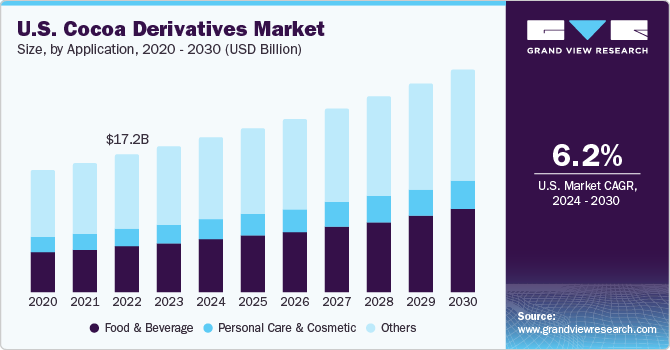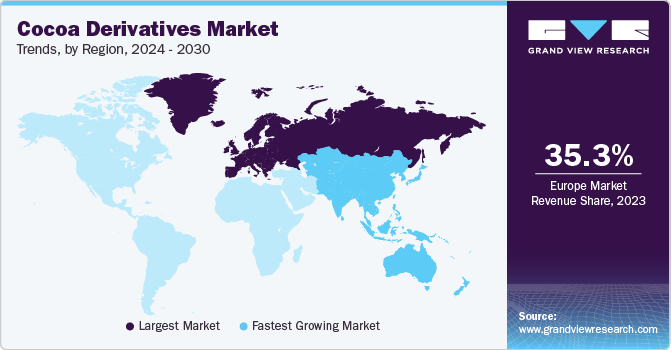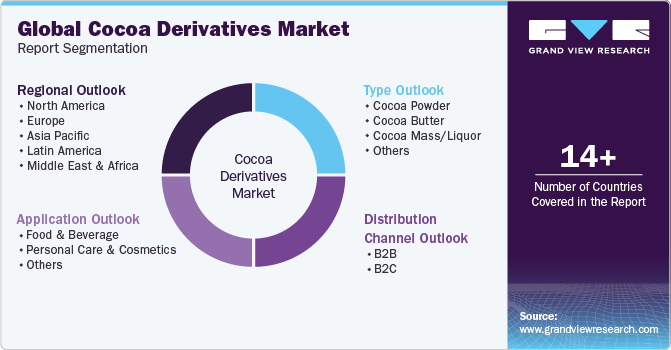
Cocoa Derivatives Market Size, Share & Trends Analysis Report By Type (Cocoa Powder, Cocoa Butter), By Application (Food & Beverage, Personal Care & Cosmetics), By Distribution Channel, By Region, And Segment Forecasts, 2024 - 2030
- Report ID: GVR-4-68040-165-1
- Number of Report Pages: 80
- Format: PDF
- Historical Range: 2018 - 2022
- Forecast Period: 2024 - 2030
- Industry: Consumer Goods
Cocoa Derivatives Market Size & Trends
The global cocoa derivatives market size was estimated at USD 23.66 billion in 2023 and is projected to grow at a compound annual growth rate (CAGR) of 6.10% from 2024 to 2030. The cocoa derivatives industry is experiencing rapid growth owing to increased demand for cocoa beans as essential ingredients. Cocoa beans are widely used in various sectors, including functional food & beverage, confectionery, pharmaceuticals, and cosmetics, due to their numerous health benefits. These benefits include fatigue syndrome regulation, excellent antioxidant properties, and the ability to mitigate hypertension's impact.

Several companies in the industry are responding to these demands by capitalizing on the trend. For example, in September 2021, the premium brand Baron Chocolatier introduced an exclusive line of bars available at Dollar Stores in the U.S. This product range features five bars in three flavors, including peanut butter, milk mousse, and creamy caramel, and is trans-fat-free, and non-GMO.
Further, the demand for cocoa derivatives is likely to increase as more consumers become aware of and seek out products with certifications and sustainable sourcing practices. As retailers continue to emphasize and expand their offerings of certified cocoa derivatives, it further reinforces the market demand for these products. Moreover, such initiatives by major retailers are contributing to the overall growth and demand for cocoa derivatives. For instance, Netherlands-based PLUS supermarket and retailers such as COOP and Waitrose in the UK and Switzerland offers certified chocolates.
Market Concentration & Characteristics
The global cocoa derivatives market is characterized by a high degree of innovation, with new products and methods being developed and introduced at regular intervals.
Several market players such as Olam Group Ltd. and Barry Callebaut AG. are involved in merger and acquisition activities. Through M&A activity, these companies can expand their geographic reach and enter new territories.

The European Union has implemented regulations to guarantee that commodities, including cocoa, are not cultivated on land that has been deforested. This initiative is backed by leading chocolate manufacturers, such as Lindt & Spruengli AG, Ferrero SpA, and Unilever Plc, as it strives to safeguard the ecosystem and the people engaged in cocoa farming.
Type Insights
In terms of type, the cocoa powder segment held the largest share in terms of revenue in 2023. Cocoa powder is widely used in the bakery and confectionery industry to add chocolate flavor and color to a wide range of products such as cakes, cookies, brownies, muffins, and pastries. The popularity of chocolate-flavored baked goods and confectionery items is fueling the demand for cocoa powder. The rising middle-class populations in emerging economies, particularly in countries like China, India, and Brazil, have led to increased demand for chocolate and cocoa products. As disposable incomes increase in these regions, there is a greater desire for indulgence and luxury food items, which boosts the demand for cocoa powder. For instance, in July 2022, India-based Lil ’Goodness announced the launch of prebiotic-based cocoa powder.
The cocoa butter segment showcased a significant CAGR during the forecast period. Cocoa butter is widely used in the cosmetics and personal care industry. It is an excellent natural moisturizer and emollient, making it popular in skincare products such as lotions, creams, lip balms, and body butter. The demand for natural and organic skincare products has grown, and cocoa butter's soothing and nourishing properties make it a sought-after ingredient.
Furthermore, innovations in the cosmetics and food industries are driving the demand for cocoa butter. Manufacturers are continuously exploring new formulations and applications for cocoa butter, leading to increased demand in various product categories. In July 2021, Cargill Beauty announced the launch of sustainably sourced cocoa butter. The cocoa butter has a distinct crystal structure which aids in fast melting and nourishes the skin.
Distribution Channel Insights
Based on distribution channel, the market is bifurcated into B2B and B2C segments. The B2B segment held the largest share in 2023. There is an increasing focus on sustainable and ethical sourcing of cocoa, which has led to the demand for certified cocoa derivatives. Many B2B buyers, such as confectionery manufacturers and food processors, prioritize sourcing cocoa derivatives from sustainable and socially responsible suppliers. B2B buyers are working closely with cocoa-producing regions and farmer cooperatives to support sustainable practices. They may provide training, technical assistance, and financial support to help farmers improve their farming techniques and adopt more sustainable methods.

The B2C segment is anticipated to grow at the fastest CAGR during the forecast period. The rising trend of convenience and snacking, especially in urban areas, has led to an increase in the demand for cocoa-containing products. Consumers are increasingly seeking quick and indulgent treats, leading to higher sales of chocolate bars, chocolate-covered snacks, and ready-to-eat chocolate products. In July 2021, England-based NOMOCHOC, a provider of chocolate products announced the launch of a vegan chocolate in the B2C range in supermarkets. The vegan chocolate range will be available in Sainsbury and Holland & Barret.
Application Insights
The food & beverage segment held the largest share in 2023. The rise in demand for premium and gourmet food and beverage products is driving the popularity of cocoa derivatives like Cocoa Mass/Liquor. These derivatives are often associated with high-quality and indulgent offerings, appealing to consumers looking for unique and upscale chocolate experiences. In July 2022, OFI, a subsidiary of Olam International announced the launch of segregated organic cocoa powder. This cocoa powder can be used in the baked goods, dairy, and confectionery industries.
The personal care & cosmetics segment is anticipated to witness the fastest CAGR over the forecast period. Consumers are becoming more aware of the potential health benefits of cocoa derivatives when applied to the skin. The association of cocoa with antioxidant properties and potential skincare benefits attracts consumers looking for natural and beneficial ingredients in their beauty routines. Sensient Cosmetic Technologies offers Natpure Xco Choco CC864, which is produced from cocoa husks and is easily soluble in personal care, hair care, and skincare products.
Regional Insights
Europe region dominated the market with a revenue share 35.3% in 2023. Europe is a diverse market for cocoa processing. There is high demand for specialty cocoa and a rising awareness of sustainability among consumers in the region. Furthermore, the rising trend of single-origin chocolate is also driving the demand for the cocoa derivatives sector. Several private-label brands and retailers such as Delicata and E-Leclerc are offering a wide range of single-origin cocoa.
Furthermore, the UK market is anticipated to showcase the fastest CAGR over the forecast period. Favorable initiatives by the government coupled with rising consumer demand for specialty chocolate are favoring the demand for cocoa derivatives in the country.

Asia Pacific’s market is expected to grow at the fastest CAGR from 2024 to 2030. The demand for cocoa ingredients in confectionery items and baked goods is witnessing significant growth in the region. Factors such as the rise of the middle-class populace coupled with rise in disposable income among the youth are driving the demand for cocoa-based derivatives.
North America is expected to witness a steady growth rate owing to the increasing demand for sustainably sourced cocoa products, which is driving the demand for cocoa derivatives in the region.
Key Companies & Market Share Insights
-
Olam Group Ltd., Cargill Inc., Barry Callebaut, JB Foods Ltd, and Ecuakao Group Ltd are some of the dominant players operating in the market
-
Barry Callebaut has a global presence and operates in approximately 160 countries
-
Ecuakao Group Ltd offers cocoa liquor, natural cocoa powder, cocoa beans, and Cocoa Mass/Liquor
Key Cocoa Derivatives Companies:
- Olam Group Ltd.
- Cargill Inc.
- Natra SA
- JB Foods Ltd
- Ecuakao Group Ltd
- United Cocoa Processor Inc.
- Indcre S.A.
- Barry Callebaut AG
- Moner Cocoa SA
- Altinmarka Gida ve Tic AS
Recent Developments
-
In August 2022, India-based healthy snack company Lil’ Goodness launched Prebiotic Cocoa Powder. It contains 100% fat-reduced, rich in antioxidants, real cocoa, and natural prebiotic fibers sourced from papaya, soybeans, citrus fruits, and cocoa beans.
-
In May 2021, Van Houten, a subsidiary of Barry Callebaut Group announced the launch of powdered chocolate sourced from ruby chocolate. Powdered chocolate is ideal for coffee bars and baristas.
Cocoa Derivatives Market Report Scope
|
Report Attribute |
Details |
|
Market size value in 2024 |
USD 25.02 billion |
|
Revenue forecast in 2030 |
USD 35.95 billion |
|
Growth rate |
CAGR of 6.2% from 2023 to 2030 |
|
Base year for estimation |
2023 |
|
Historical data |
2018 - 2022 |
|
Forecast period |
2024 - 2030 |
|
Quantitative units |
Volume in kilotons, revenue in USD million/billion, and CAGR from 2024 to 2030 |
|
Report coverage |
Volume & revenue forecast, company ranking, competitive landscape, growth factors, and trends |
|
Segments covered |
Type, application, distribution channel, region |
|
Regional scope |
North America; Europe; Asia Pacific; Central & South America; Middle East & Africa |
|
Country scope |
U.S.; Canada; U.K.; Germany; France; Italy; Spain; Japan; China; India; Australia & New Zealand; Brazil; Argentina; South Africa; UAE; Saudi Arabia |
|
Key companies profiled |
Olam Group Ltd.; Cargill Inc.; Natra SA; JB Foods Ltd; Ecuakao Group Ltd; United Cocoa Processor Inc.; Indcre S.A.; Barry Callebaut AG; Moner Cocoa SA; Altinmarka Gida ve Tic AS |
|
Customization scope |
Free report customization (equivalent up to 8 analysts working days) with purchase. Addition or alteration to country, regional & segment scope. |
|
Pricing and purchase options |
Avail customized purchase options to meet your exact research needs. Explore purchase options |
Global Cocoa Derivatives Market Report Segmentation
This report forecasts volume & revenue growth at global, regional & country levels and provides an analysis of the industry trends in each of the sub-segments from 2018 to 2030. For this study, Grand View Research has segmented the global cocoa derivatives market report based on type, application, distribution channel, and region:

-
Type Outlook (Volume, Kilotons; Revenue, USD Million, 2018 - 2030)
-
Cocoa Powder
-
Cocoa Butter
-
Cocoa Mass/Liquor
-
Others
-
-
Application Outlook (Volume, Kilotons; Revenue, USD Million, 2018 - 2030)
-
Food & Beverage
-
Personal Care & Cosmetics
-
Others
-
-
Distribution Channel Outlook (Volume, Kilotons; Revenue, USD Million, 2018 - 2030)
-
B2B
-
B2C
-
Online sales
-
Hypermarkets/Supermarkets
-
Wholesale Stores
-
Others
-
-
-
Regional Outlook (Volume, Kilotons; Revenue, USD Million, 2018 - 2030)
-
North America
-
U.S.
-
Canada
-
-
Europe
-
U.K.
-
Germany
-
France
-
Italy
-
Spain
-
-
Asia Pacific
-
China
-
Japan
-
India
-
Australia & New Zealand
-
South Korea
-
-
Latin America
-
Brazil
-
Argentina
-
-
Middle East & Africa
-
Saudi Arabia
-
UAE
-
-
Frequently Asked Questions About This Report
b. The global cocoa derivatives market size was estimated at USD 23.66 billion in 2023 and is expected to reach USD 25.04 billion in 2024.
b. The cocoa derivatives market is expected to grow at a compound annual growth rate of 6.2% from 2022 to 2030 to reach USD 35.95 billion by 2030.
b. The Europe market held a dominant revenue share of 35.2% in 2023 owing to the rise in the number of consumers seeking sustainably sourced and single-origin chocolates.
b. Some of the major players in the market include Olam Group Ltd., Cargill Inc., Natra SA, JB Foods Ltd, Ecuakao Group Ltd, United Cocoa Processor Inc., Indcre S.A., Barry Callebaut AG, Moner Cocoa SA, and Altinmarka Gida ve Tic AS among others.
b. The rising popularity of confectionery products coupled with popularity of sugary treats among all age groups is supporting the demand for the market.
We are committed towards customer satisfaction, and quality service.
"The quality of research they have done for us has been excellent."




